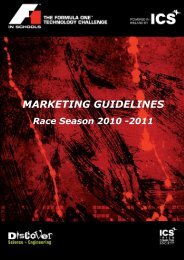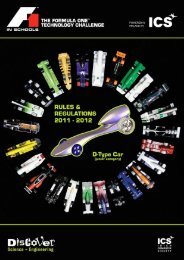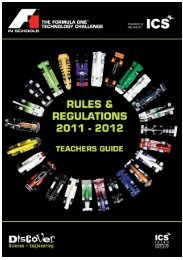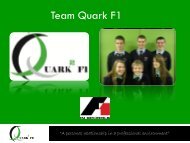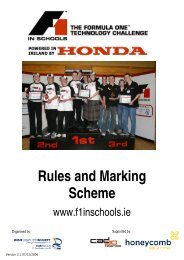Rules and Regulations R-Type - F1 in Schools
Rules and Regulations R-Type - F1 in Schools
Rules and Regulations R-Type - F1 in Schools
Create successful ePaper yourself
Turn your PDF publications into a flip-book with our unique Google optimized e-Paper software.
<strong>Rules</strong> <strong>and</strong> <strong>Regulations</strong>R-<strong>Type</strong>
What is the <strong>F1</strong> <strong>in</strong> <strong>Schools</strong> Challenge?GETTING STARTEDThe <strong>F1</strong> <strong>in</strong> <strong>Schools</strong> is a global multi-discipl<strong>in</strong>ary competition, that challenges secondaryschool students <strong>in</strong> the Republic of Irel<strong>and</strong>, to design, build <strong>and</strong> race m<strong>in</strong>iature compressed airpoweredbalsa wood Formula One cars. Student teams will compete aga<strong>in</strong>st each other <strong>in</strong> theNational F<strong>in</strong>al to determ<strong>in</strong>e the best eng<strong>in</strong>eered <strong>and</strong> fastest car <strong>in</strong> Irel<strong>and</strong>.Design will play a critical role <strong>in</strong> the success of your team - both <strong>in</strong> the design of the car itself<strong>and</strong> the people <strong>in</strong>volved <strong>in</strong> br<strong>in</strong>g<strong>in</strong>g that design from the <strong>in</strong>itial idea right through to the start<strong>in</strong>ggrid. Team members must be carefully chosen <strong>and</strong> tra<strong>in</strong>ed to work together, us<strong>in</strong>g cutt<strong>in</strong>g edgedesign software <strong>and</strong> the latest <strong>in</strong> manufactur<strong>in</strong>g technology.Students are encouraged to use software tools to manage their projects <strong>and</strong> to develop aproject website to communicate how their designs evolved.Left: National Champions 2009 TeamBl<strong>in</strong>k, St. Ailbe’s Secondary School,TipperaryRight: National Championshipw<strong>in</strong>n<strong>in</strong>g carThe 2008/09 Challenge was a great success with 90 teams compet<strong>in</strong>g at Regional F<strong>in</strong>al stage.All Regional F<strong>in</strong>als for the 2009/10 season will be held <strong>in</strong> March. The Challenge is part ofan <strong>in</strong>ternational competition which <strong>in</strong> September 2009 will see 32 teams from 20 countriescompete for the crown. The 2008 World Champions are Team Pulse from Engl<strong>and</strong>.Similar rules <strong>and</strong> regulations cont<strong>in</strong>ue to apply to your R-TYPE car designs as for the D-TYPE.Similarly, all cars <strong>in</strong> the championship will cont<strong>in</strong>ue to be powered by identical specification eng<strong>in</strong>es- compact compressed air powerplants. The R-TYPE presents a different eng<strong>in</strong>eer<strong>in</strong>g<strong>and</strong> design challenge to test <strong>and</strong> develop your eng<strong>in</strong>eer<strong>in</strong>g skills even further.The <strong>F1</strong> <strong>in</strong> <strong>Schools</strong> Challenge is managed by the Irish Computer Society <strong>in</strong> partnership withDiscover Science <strong>and</strong> Eng<strong>in</strong>eer<strong>in</strong>g.<strong>F1</strong> <strong>in</strong> <strong>Schools</strong> Technology Challenge 2
THE DESIGN BRIEFThe BriefYou are the Formula One Team commissioned to design, construct <strong>and</strong> race the fastest Formula OneCar of the Future, driven by compact compressed air powerplants (cartridges). The particular design specifications<strong>and</strong> rac<strong>in</strong>g regulations for this controlled rac<strong>in</strong>g are outl<strong>in</strong>ed <strong>in</strong> this document.To succeed <strong>in</strong> the challenge you will need to work with modern design technologies like 3D CAD software.In order to enter the Championship, you must allocate job roles to the members of your group. Ideally, onerole should be allocated to each person. However, you may have to double up on your role <strong>and</strong> responsibilities,depend<strong>in</strong>g on the number of people you have available.The follow<strong>in</strong>g job roles should be covered by the members of your team:Team Manager (maximum 1 person). This person will be responsible for manag<strong>in</strong>g theteam, ensur<strong>in</strong>g that the car is ready for the f<strong>in</strong>als. The team manager works closely withall members of the team, offer<strong>in</strong>g assistance where necessary.Resources Manager (maximum 1 person). This person organises time, materials <strong>and</strong>equipment for design <strong>and</strong> mak<strong>in</strong>g the cars. The resources manager will need to liaisewith all members to check tasks are progress<strong>in</strong>g on time <strong>and</strong> offer additional help, ifneeded.Manufactur<strong>in</strong>g Eng<strong>in</strong>eer (maximum 2 persons). These people are responsible for advis<strong>in</strong>gteam members on the manufacture of the car <strong>and</strong> the constra<strong>in</strong>ts of the mach<strong>in</strong><strong>in</strong>gprocess. Manufactur<strong>in</strong>g eng<strong>in</strong>eers will need to liaise with the design eng<strong>in</strong>eers to report<strong>and</strong> help solve any problems with construction of the car.Design Eng<strong>in</strong>eer (maximum 2 persons). These people are responsible for the styl<strong>in</strong>g<strong>and</strong> aerodynamic performance of the car design. Design eng<strong>in</strong>eers will need to liaise withthe manufactur<strong>in</strong>g eng<strong>in</strong>eers to ensure their ideas can be realised.Graphic Designer (maximum 1 person). This person will be responsible for produc<strong>in</strong>gthe colour schemes applied to the vehicle, <strong>in</strong>clud<strong>in</strong>g any special sponsorship decals, togetherwith the f<strong>in</strong>al graphic render<strong>in</strong>gs <strong>and</strong> any additional team market<strong>in</strong>g materials. Thegraphic designer will need to liaise with the design eng<strong>in</strong>eer to ensure any schemes willfit the shape of the vehicle <strong>and</strong> the market<strong>in</strong>g <strong>and</strong> communications manager for additionalmarket<strong>in</strong>g development.Market<strong>in</strong>g <strong>and</strong> Communications Manager (maximum 1 person). This person will beresponsible for develop<strong>in</strong>g team market<strong>in</strong>g <strong>and</strong> sponsorship generation. The market<strong>in</strong>g<strong>and</strong> communications manager will need to liaise with <strong>F1</strong> <strong>in</strong> School’s Market<strong>in</strong>g Team,local media <strong>and</strong> potential sponsors to ensure maximum coverage for their team.There are so many tasks that must be mastered, <strong>in</strong> order to design, manufacture, prepare <strong>and</strong> f<strong>in</strong>ally entera car for rac<strong>in</strong>g, that teamwork will be vital to your success. A real <strong>F1</strong> team succeeds because all thepeople learn to work together <strong>and</strong> support each other.Remember, no one person is more important than another.<strong>F1</strong> <strong>in</strong> <strong>Schools</strong> Technology Challenge 3
THE DESIGN BRIEFSpecific RequirementsYour team must comply with all the guidel<strong>in</strong>es outl<strong>in</strong>ed below:Your team must conta<strong>in</strong> a m<strong>in</strong>imum of 3 to a maximum of 6 students.Due to the <strong>in</strong>creas<strong>in</strong>g numbers enter<strong>in</strong>g the competition it has been necessary to <strong>in</strong>troduce aQualify<strong>in</strong>g stage. Entry to this Qualify<strong>in</strong>g Stage will be open to all schools <strong>and</strong> entry is free.Each school can enter as many teams as they wish for the Qualify<strong>in</strong>g Stage, but a maximum of twoteams from each category (Junior / Senior Cycle) will be allowed to progress through to theRegional F<strong>in</strong>als.Teams must be registered by 16th October 2009. Registration is onl<strong>in</strong>e at www.<strong>F1</strong><strong>in</strong><strong>Schools</strong>.ieThe Qualify<strong>in</strong>g Stage will be judged follow<strong>in</strong>g the submission of a 5 page plan (submissiondeadl<strong>in</strong>e 6th November 2009). The details for this Stage follow <strong>in</strong> this document under theQualify<strong>in</strong>g Stage head<strong>in</strong>g on pages 8 <strong>and</strong> 9.Teams’ 5 page plans are judged to select approximately 100 teams to progress to Manufactur<strong>in</strong>g<strong>and</strong> Regional F<strong>in</strong>al stage. The teams that score highest <strong>in</strong> the Qualify<strong>in</strong>g Stage will proceed throughto the Regional F<strong>in</strong>als. All schools will be notified by email if they have/have not succeeded <strong>in</strong>progress<strong>in</strong>g through to the Regional F<strong>in</strong>al stage. There is a fee of €80 per team for those whoqualify for the Regional F<strong>in</strong>al stage.If it is your school’s third time to enter the Challenge <strong>and</strong> your team is a Senior Cycle team, youmust design the R-<strong>Type</strong> car. For details on Competition Categories, view page 15 of thisdocument.Your team must use 3D CAD (Computer Aided Design) software to produce your ideas <strong>and</strong> modelthem <strong>in</strong> 3D. Details on how to obta<strong>in</strong> your free copy of Solid Works software from <strong>F1</strong> <strong>in</strong> <strong>Schools</strong> isavailable on the website (www.f1<strong>in</strong>schools.ie).The dimensions of your car body, together with the wheels, must fit the dimensions outl<strong>in</strong>ed <strong>in</strong>the rules. Marks will be deducted otherwise. Please check these very carefully.The car body must be mach<strong>in</strong>ed from a s<strong>in</strong>gle piece of balsa wood. The front aerofoil <strong>and</strong> rearaerofoil may be mach<strong>in</strong>ed from a separate non-metallic material e.g. ABS. This applies also tosupport<strong>in</strong>g structures.Each car body must be manufactured either at your school or at a designated Manufactur<strong>in</strong>gCentre, which <strong>F1</strong> <strong>in</strong> <strong>Schools</strong> will pair your team with. Your team must use a CNC mach<strong>in</strong>e, suchas the Denford MicroRouter to produce the car body.Each car body must be completed with a high quality pa<strong>in</strong>ted f<strong>in</strong>ish. Note that only a limited amountof h<strong>and</strong> f<strong>in</strong>ish<strong>in</strong>g to the body is allowed. Only one car is required at regional <strong>and</strong> national f<strong>in</strong>al level.At Regional <strong>and</strong> National F<strong>in</strong>al stages each team must produce a design portfolio which detailsthe design, production <strong>and</strong> evaluation process <strong>in</strong>clud<strong>in</strong>g, <strong>in</strong>itial ideas, design development,manufacture <strong>and</strong> evidence of test<strong>in</strong>g <strong>and</strong> evaluation. Max 20 pages (A3). It should be noted thatpo<strong>in</strong>ts are awarded for ICT <strong>in</strong> the design of your portfolio.At Regional <strong>and</strong> National F<strong>in</strong>al stages each team must supply a 1 st or 3 rd angle orthographicprojection <strong>and</strong> a graphic render<strong>in</strong>g of their f<strong>in</strong>al design, both produced us<strong>in</strong>g a 3D CAD package.At Regional <strong>and</strong> National F<strong>in</strong>al stages each team must complete a specification sheet, which mustbe displayed at each race event. This specification sheet should be completed before arriv<strong>in</strong>g at therace event.At Regional <strong>and</strong> National F<strong>in</strong>al stages teams must prepare a verbal presentation on their work. 5m<strong>in</strong>utes will be allocated to present to the judges.Note: The guidel<strong>in</strong>es listed above are m<strong>in</strong>imum requirements. Please review the <strong>Rules</strong> <strong>and</strong> <strong>Regulations</strong> <strong>and</strong> mark<strong>in</strong>gscheme further <strong>in</strong> this document.<strong>F1</strong> <strong>in</strong> <strong>Schools</strong> Technology Challenge 4
THE DESIGN BRIEFDesign ConsiderationsDesign Preparation:Before beg<strong>in</strong>n<strong>in</strong>g to design your car, you willneed: Solid Works or a similar 3D CAD softwarepackage at your school/college. A design template suitable for the balsawood blank. (this can be downloaded atwww.<strong>F1</strong><strong>in</strong><strong>Schools</strong>.ie/resources) Hopefully, an endless supply of ideas!Tra<strong>in</strong><strong>in</strong>g:CAD packages will help you draw <strong>and</strong> developyour ideas <strong>in</strong> 3D. Of course, as with most draw<strong>in</strong>gpackages, it takes time to learn how to use them.Your technology teacher should be able to showyou how the software works, but members of yourteam will need to spend some time explor<strong>in</strong>g thesoftware, so you can see what it can do <strong>and</strong> howit can help you design your <strong>F1</strong> car.Research:Investigate exist<strong>in</strong>g <strong>F1</strong> car designs. Your teachermay be able to help you use the <strong>in</strong>ternet to f<strong>in</strong>dout the latest developments occurr<strong>in</strong>g <strong>in</strong> the worldof <strong>F1</strong> design. Team photos from last year’sChallenge can be found at www.<strong>F1</strong><strong>in</strong><strong>Schools</strong>.ie <strong>in</strong>the Gallery section. Concentrate your research onareas that could help your team, for example,aerodynamics, car body designs <strong>and</strong> wheeldesigns, then try to apply the pr<strong>in</strong>ciples to yourown ideas.Test<strong>in</strong>g:Your team may want to consider test<strong>in</strong>g a varietyof car designs, or car parts, <strong>in</strong> a virtual w<strong>in</strong>d tunnelor physical w<strong>in</strong>d <strong>and</strong>/or smoke tunnel, if yourMake Centre has access to one, to evaluate theiraerodynamic performance.If your school has a copy of Solid Works youshould also have <strong>in</strong>cluded a copy of COSMOS,Solid Works design analysis software.COSMOSFlowXpress can be used to quicklyanalyze the Race Car Block part which is used <strong>in</strong>the Race Car Assembly.COSMOSFloXpress is a fluid dynamicsapplication that calculates how fluid, (air or water)flows through a part or assembly model. Based onthe calculated velocity field, you can f<strong>in</strong>d problemareas <strong>in</strong> your design <strong>and</strong> improve them before youmanufacture any parts.Manufactur<strong>in</strong>g ConsiderationsIn the <strong>F1</strong> Car Kit that each team qualify<strong>in</strong>g for theRegional f<strong>in</strong>al stage will receive, is a balsa woodblock, a set of 4 wheels <strong>and</strong> 2 axles, which is them<strong>in</strong>imum that you need to compete at Regionalf<strong>in</strong>al stage.Note that your car design template must be10mm shorter at least at one end, compared tothe actual balsa wood block (we have accountedfor this <strong>in</strong> the <strong>Rules</strong> & <strong>Regulations</strong>, po<strong>in</strong>t 3a). Youwill not be able to mach<strong>in</strong>e to the extreme endsof the balsa wood block, s<strong>in</strong>ce they aresometimes used for attach<strong>in</strong>g the CNC mach<strong>in</strong>ejig fixtures. Damage could occur if the cutt<strong>in</strong>g toolhits any of these jig fixtures.The jig is used to stop the balsa wood blockmov<strong>in</strong>g whilst be<strong>in</strong>g mach<strong>in</strong>ed. It also allows theblock to be accurately repositioned. Please notehowever that some mach<strong>in</strong>es will require onlyone cut, others may require two cuts, thereforeyou will need to take this <strong>in</strong>to account when youare design<strong>in</strong>g the car.Manufactur<strong>in</strong>g of cars must occur at an approved<strong>F1</strong> <strong>in</strong> <strong>Schools</strong> Manufactur<strong>in</strong>g Centre (3rd level<strong>in</strong>stitution), which <strong>F1</strong> <strong>in</strong> <strong>Schools</strong> will pair yourteam with, or if your school has facilities, <strong>in</strong> yourown school.Once mach<strong>in</strong>ed, you can smooth down the balsawood design <strong>and</strong> f<strong>in</strong>ish with primer <strong>and</strong> pa<strong>in</strong>t.Note that only a limited amount of h<strong>and</strong> f<strong>in</strong>ish<strong>in</strong>gto the body is allowed. Filler should not be usedto build up areas of your car. You can alsodecorate the car body with any sponsorshipstickers, advertis<strong>in</strong>g or colour schemes.Sponsorship ConsiderationsWhen seek<strong>in</strong>g team sponsorship, please ensurethat the proposed sponsor of your team does notconflict with the <strong>F1</strong> <strong>in</strong> <strong>Schools</strong> TechnologyChallenge sponsors.If you are unsure if your potential sponsor willconflict please contact f1@ics.ie for confirmation<strong>F1</strong> <strong>in</strong> <strong>Schools</strong> Technology Challenge 5
THE DESIGN BRIEFRight: 3D render<strong>in</strong>g of the blank balsa wood,used for construction of the R-TYPE car.Below: Third angle orthographic projection of the R-TYPE blank balsa wood block.All dimensions shown are <strong>in</strong> mm (millimeters). Note—the draw<strong>in</strong>g is NOT TO SCALE<strong>F1</strong> <strong>in</strong> <strong>Schools</strong> Technology Challenge 6
TIMELINE 2009-10<strong>F1</strong> <strong>in</strong> <strong>Schools</strong> Technology Challenge 7
QUALIFYING STAGECompulsory Qualify<strong>in</strong>g Stage – The First Step onto the Grid!!You are a Formula One team who must pitch your plan to build the Fastest Formula One Car ofthe Future, driven by compressed air powerplants.You must submit a plan which demonstrates why your team should be chosen to get your designconstructed to race.Your plan should give details of your team members, show some areas of your teams research, displayyour <strong>in</strong>itial design ideas <strong>and</strong> show some elements of your portfolio e.g. timel<strong>in</strong>e, br<strong>and</strong><strong>in</strong>g etc…Remember, your team must show why your plan is the best!Your ideas <strong>and</strong> plan should be orig<strong>in</strong>al, if you want to be chosen, be different!Plan –maximum 5 pages (A4)All team plans must be submitted by 5pm 6th November 2009Plans should be submitted by email to f1@ics.ie or by post to:ICS, Crescent Hall, Mount Street Crescent, Dubl<strong>in</strong> 2Your plan should consist of the follow<strong>in</strong>g:Introduction (1 page)Research (1 page)A look at the different ideas beh<strong>in</strong>d mak<strong>in</strong>g your car the fastest.Design (1-2 pages)Pencil sketch will suffice, but 3D CAD more advantageousResources plann<strong>in</strong>g (1-2 pages)Outl<strong>in</strong>e plan to <strong>in</strong>clude, for example: timel<strong>in</strong>e, budget, market<strong>in</strong>g etc..Plans should have no more than 5 A4 pages, any plans which exceed the maximum of 5 pages will onlyhave the first 5 pages looked at. The cover of your document is not counted <strong>in</strong> these 5 pages.To view a sample plans, log on to www.<strong>F1</strong><strong>in</strong><strong>Schools</strong>.ieW<strong>in</strong>n<strong>in</strong>g teams <strong>in</strong>novate!!Formula One is constantly <strong>in</strong>novat<strong>in</strong>g <strong>in</strong> all areas of the Formula One bus<strong>in</strong>ess i.e. design, research,market<strong>in</strong>g. Has your team a dist<strong>in</strong>ct advantage, if so tell us about it <strong>and</strong> earn your team an additional 10%of your overall marks for the plan!! For further breakdown of marks for Qualify<strong>in</strong>g Stage, view page 9 ofthis document.Submit one additional item that can take the form of, for example, one of the follow<strong>in</strong>g:An additional A4 page of text or imagesA slide showA videoA team logoMaximum duration of digital media 3 m<strong>in</strong>utes.<strong>F1</strong> <strong>in</strong> <strong>Schools</strong> Technology Challenge 8
Mark<strong>in</strong>g Scheme for Qualify<strong>in</strong>g StageQUALIFYING STAGEArea Key Features Po<strong>in</strong>ts AwardedIntroductionOne page <strong>in</strong>troduction to team, job roles, teammissionMax 10 po<strong>in</strong>tsResearchOne page featur<strong>in</strong>g areas researched by the team forthe competition e.g. aerodynamics, wheel design…..Max 10 po<strong>in</strong>tsDesign1-2 pages of <strong>in</strong>itial sketches of design/designs.Development of ideas can be by h<strong>and</strong> or with 3DCAD. Teams should show development of thoughts<strong>and</strong> ideas through use of research.Note: Use of ICT/CAD is essential to achievemaximum po<strong>in</strong>tsMax 40 po<strong>in</strong>tsBrief1 – 2 pages where teams outl<strong>in</strong>e what their plan wouldbe, if they proceed through to the Regional F<strong>in</strong>als.This may <strong>in</strong>clude how they would allocate their time,fund their materials/transport, <strong>and</strong> their range ofactivities (e.g. project-management, graphic design,market<strong>in</strong>g, sponsorship etc.).Max 40 po<strong>in</strong>tsInnovationAn additional 10% of the teams overall mark for above can be achieved bysubmitt<strong>in</strong>g one item to demonstrate your teams <strong>in</strong>novation.*To achieve the highest marks <strong>in</strong> each category teams should use ICT <strong>and</strong> CAD, where possible.*Note:At Regional F<strong>in</strong>al stage po<strong>in</strong>ts may be deducted from team’s scores if significant elements of<strong>in</strong>itial plans are not achieved. Therefore you should ensure your plans are realistic.<strong>F1</strong> <strong>in</strong> <strong>Schools</strong> Technology Challenge 9
CONSUMABLES/AWARDSManufactur<strong>in</strong>g CentresTeams will be paired with a Manufactur<strong>in</strong>g Centre (3 rd level <strong>in</strong>stitution) by <strong>F1</strong> <strong>in</strong> <strong>Schools</strong>, if youdo not have facilities <strong>in</strong> your school.How to obta<strong>in</strong> software, hardware <strong>and</strong> consumablesTo obta<strong>in</strong> your free copy of Solid Works software from <strong>F1</strong> <strong>in</strong><strong>Schools</strong> visit the website (www.f1<strong>in</strong>schools.ie).If you would like to purchase any equipment for thechallenge please contact:Sureweld Educational Division, Fonthill, Lucan, Co. Dubl<strong>in</strong>Tel: 01 6266 242Or contact T4 (Technology Subjects Support Service) for alist of approved equipment.Tel: 091 745 650Team Prizes <strong>and</strong> AwardsThere will be separate awards for:The Overall W<strong>in</strong>ner of the ChallengeThe 1st, 2nd <strong>and</strong> 3rd W<strong>in</strong>ners <strong>in</strong> each CategoryThe Fastest CarNote: Awards are at theThe Best Eng<strong>in</strong>eered Cardiscretion of the judges.Best Use of ICTBest Team WebsiteThe Best Team Market<strong>in</strong>g <strong>and</strong> SponsorshipBest NewcomerPrizes will be awarded at National F<strong>in</strong>al level. Prize packages to be confirmed.Each <strong>F1</strong> <strong>in</strong> <strong>Schools</strong> competitor will receive a certificate of participation.Enquiries <strong>and</strong> QuestionsAll questions <strong>and</strong> queries about the <strong>F1</strong> <strong>in</strong> <strong>Schools</strong>Technology Challenge should be e-mailed to: f1@ics.ieFor the very latest <strong>in</strong>formation, visit the <strong>F1</strong> <strong>in</strong> <strong>Schools</strong>Technology Challenge website (www.<strong>F1</strong><strong>in</strong><strong>Schools</strong>.ie)<strong>F1</strong> <strong>in</strong> <strong>Schools</strong> Technology Challenge 10
RULES & REGULATIONS1. General <strong>Regulations</strong>1a. All cars must be designed us<strong>in</strong>g a CAD/CAMpackage. The CAD package used mustsatisfy all the challenge entry criteria <strong>and</strong>allow students to produce a 3D graphicrender<strong>in</strong>g <strong>and</strong> 1 st or 3 rd angle orthographicprojection. Your <strong>F1</strong> car must be manufacturedon a CNC mach<strong>in</strong>e, such as a DenfordMicroRouter, either at your school or at an <strong>F1</strong><strong>in</strong> <strong>Schools</strong> approved Manufactur<strong>in</strong>g Centre.1b. All teams must be registered before 16thOctober 2009 <strong>in</strong> preparation for Qualify<strong>in</strong>gStage submission of plans on 6th November2009. Registration is onl<strong>in</strong>e atwww.<strong>F1</strong><strong>in</strong><strong>Schools</strong>.ie1c. Students to submit a 5 page summaryportfolio document by 6th November 2009.1d. Each team should consist of a m<strong>in</strong>imum of 3members to a maximum of 6. Mixed genderteams would be preferred <strong>and</strong> positivelyencouraged.1e. Contact details for the Team Manager shouldbe provided, to enable <strong>F1</strong> <strong>in</strong> <strong>Schools</strong> to liaisewith them, this is completed at time ofregistration on www.<strong>F1</strong><strong>in</strong><strong>Schools</strong>.ie. All teammembers’ roles must be entered onl<strong>in</strong>ebefore Regional f<strong>in</strong>als.1f. All cars must be designed consider<strong>in</strong>g thespecified dimensions <strong>and</strong> regulations. Only alimited amount of h<strong>and</strong> f<strong>in</strong>ish<strong>in</strong>g (at theJudges’ discretion) is permitted. We expect allcars to be complete, f<strong>in</strong>ished <strong>and</strong> pa<strong>in</strong>ted to ahigh st<strong>and</strong>ard.1g. Only a limited amount of filler is permitted. Itshould not be used to build up areas.Disqualification may occur wheremeasurement of orig<strong>in</strong>al draw<strong>in</strong>g <strong>and</strong> f<strong>in</strong>al carhave significant discrepancies.1h. Teams must show evidence of any mediafootage or press clipp<strong>in</strong>gs <strong>in</strong> order to beawarded marks for such media coveragegenerated.1i. The official length of the track, from start<strong>in</strong>gl<strong>in</strong>e to f<strong>in</strong>ish l<strong>in</strong>e, is 20 metres.1j. The <strong>F1</strong> car body must be mach<strong>in</strong>ed from as<strong>in</strong>gle piece of balsa wood. The front aerofoil<strong>and</strong> the rear aerofoil may be mach<strong>in</strong>ed from aseparate non-metallic material. The design ofthe axle <strong>and</strong> bear<strong>in</strong>g systems is unrestricted.1k. Teams that have been <strong>in</strong>vited to the RegionalF<strong>in</strong>als <strong>and</strong> National f<strong>in</strong>al will be required toexpla<strong>in</strong> how they completed their designprocess to the Judges, <strong>in</strong> the form of a verbalpresentation, with optional accompany<strong>in</strong>gvisual aids. The presentation must not lastlonger than 5 m<strong>in</strong>utes. Extra time is providedfor set up <strong>and</strong> Judges questions.1l. Should any teams withdraw or becomedisqualified from the Regional F<strong>in</strong>al stage;reserve teams may be selected from apreviously submitted list. These teams will be<strong>in</strong>formed by post/e-mail/telephone call as soonas the organisers are aware of the situation.1m.The cars should be produced <strong>in</strong> the sameyear as the f<strong>in</strong>als. The same car design shouldnot be entered more than once.1n. Each design must leave enough space for anentry number sticker to be applied on eachside of the car body. Your number will begiven to you at registration <strong>and</strong> must be <strong>in</strong>place before rac<strong>in</strong>g. The size of the sticker willbe a maximum of 40mm (length) by 25mm(height).1o. At Regional <strong>and</strong> National F<strong>in</strong>al stage eachteam must produce a design folder of workcover<strong>in</strong>g all aspects of the project <strong>in</strong>clud<strong>in</strong>g<strong>in</strong>itial ideas, design development <strong>and</strong> evidenceof test<strong>in</strong>g. These documents should bepresented <strong>in</strong> an A3 sized portfolio <strong>and</strong>displayed <strong>in</strong> the pits area throughout theduration of the event - no more than 20 sheetsof A3 per portfolio.1p. A dimensioned orthographic projection(<strong>in</strong>clud<strong>in</strong>g a plan, side <strong>and</strong> end elevation) oftheir car design <strong>and</strong> a 3D render<strong>in</strong>g, bothcompleted us<strong>in</strong>g a CAD package, must alsobe submitted <strong>in</strong> your design folder.<strong>F1</strong> <strong>in</strong> <strong>Schools</strong> Technology Challenge 11
RULES & REGULATIONS1. General <strong>Regulations</strong> (cont<strong>in</strong>ued)1p. All cars will be checked for safety <strong>and</strong> that thescrew eyes are secure. If the Judge /RaceOfficials are unhappy with the safety of thevehicle or a rule <strong>in</strong>fr<strong>in</strong>gement has occurred,the team may be disqualified or po<strong>in</strong>tsdeducted from the overall team score.1q. Judg<strong>in</strong>g will <strong>in</strong>clude categories as detailed <strong>in</strong>the mark<strong>in</strong>g criteria. Overall w<strong>in</strong>ners will bedeterm<strong>in</strong>ed by comb<strong>in</strong><strong>in</strong>g po<strong>in</strong>t scores from allcategories <strong>in</strong> the Challenge. Other prizes aredeterm<strong>in</strong>ed on separate or comb<strong>in</strong>ationcategory totals. PLEASE NOTE THEJUDGES’ DECISION IS FINAL.1r. Cars will be h<strong>and</strong>ed <strong>in</strong>to race control 10m<strong>in</strong>utes before rac<strong>in</strong>g commences.1s. Cars once h<strong>and</strong>ed over to Race Officials mustnot be h<strong>and</strong>led by anyone except on theexplicit <strong>in</strong>structions of the Race Official. TheRace Official will <strong>in</strong>struct team members onthe h<strong>and</strong>l<strong>in</strong>g of their car on the track.1t. The Challenge is open to all secondaryschools, exclud<strong>in</strong>g employees <strong>and</strong> theirfamilies of Irish Computer Society, agents oranyone else professionally connected with thispromotion1u. The top teams at the Regional F<strong>in</strong>als fromeach Category will be <strong>in</strong>vited to challengeother teams from around the country at theNational F<strong>in</strong>al. The Overall W<strong>in</strong>ner of theNational F<strong>in</strong>al has the option to representIrel<strong>and</strong> at the International F<strong>in</strong>al. If for somereason the National w<strong>in</strong>n<strong>in</strong>g team cannotattend the International F<strong>in</strong>als second choicewill be at the discretion of the organisers.1v. ICS <strong>and</strong> its partners may require the use ofthe Team car <strong>and</strong>/or portfolio <strong>and</strong> displayitems for media <strong>and</strong> promotional purposes.Teams agree to allow ICS to the use of theseas required post events.1w. Tolerances for all specifications.Dimension tolerance is +/- 0.1mmWeight tolerance is +/- 0.5 grams.See page 17 <strong>and</strong> 18 of this documentwhich illustrates the application ofsome of the follow<strong>in</strong>g rules.2. Body & Side Pod <strong>Regulations</strong>All cars must comply with the follow<strong>in</strong>g m<strong>in</strong>imum<strong>and</strong> maximum dimensions.2a. Full body lengthM<strong>in</strong>: 170mm / Max: 210mm(Measured between front & rear extremitiesof the body)2b. Body height above the trackM<strong>in</strong>: 3mm / Max: 15mm(Exclud<strong>in</strong>g eyelets, but <strong>in</strong>clud<strong>in</strong>g side pods<strong>and</strong> w<strong>in</strong>gs. Measured from track surface tothe car body) -This applies to the undersideof the car measured between the axles <strong>and</strong>side pods <strong>in</strong>clud<strong>in</strong>g the slot.2c. Width at side podsM<strong>in</strong>: 50mm / Max: 65mm(The completed design must <strong>in</strong>clude 2 sidepods. These are measured from side to sideof the car body. The side pods are def<strong>in</strong>ed asa feature on the car between the front <strong>and</strong>rear wheels that exists between the 50mmm<strong>in</strong>imum <strong>and</strong> 65mm maximum tolerances.Any part less than a width of 50mm isconsidered to be the car body only. Viewedfrom the side, a side pod must present asurface measur<strong>in</strong>g not less than 30mm wideby 15mm high. A sticker of this size will beapplied <strong>and</strong> must be 100% visible from theside view)2d. Total car width, <strong>in</strong>clud<strong>in</strong>g wheelsM<strong>in</strong>: 60mm / Max: 85mm(Measured between outside edges of thewheels or body, whichever is widest)2e. Body weight without the CO 2 cartridgeM<strong>in</strong>: 55.0grams2f. No part of the body or side pods should beless than 3.5mm thick. All edges must have aradius of at least 1.5mm when the adjo<strong>in</strong><strong>in</strong>gsurfaces angle is less than 90°2g. Maximum body height(<strong>in</strong>clud<strong>in</strong>g aerofoils) - 60mm2h. The car body <strong>in</strong>clud<strong>in</strong>g side pods, must bemach<strong>in</strong>ed from a s<strong>in</strong>gle piece of balsa wood.2i. No implants or hidden voids <strong>in</strong> the car bodyare allowed.2j. A driver cockpit/driver is an optional feature.<strong>F1</strong> <strong>in</strong> <strong>Schools</strong> Technology Challenge 12
RULES & REGULATIONS2. Body & Side Pod <strong>Regulations</strong>2k. Viewed from the top, a projected rectangularsurface of 30 X 50mm m<strong>in</strong>imum must exist <strong>in</strong>the area bounded by the side pad extremities.3. Wheel <strong>Regulations</strong>3a. All <strong>F1</strong> cars must have 4 wheels, two at thefront, two at the rear <strong>and</strong> all wheels must becyl<strong>in</strong>drical <strong>and</strong> must fit the follow<strong>in</strong>g criteria.3b. Front wheel diameterM<strong>in</strong>: 26 / Max: 34mm(Measured to the extreme outer edges of eachwheel)3c. Front wheel widthM<strong>in</strong>: 15 / Max: 19mm(At surface contact po<strong>in</strong>t. Measured betweenthe extreme edges)3d. Rear wheel diameterM<strong>in</strong>: 26 / Max: 34mm(Measured to the extreme outer edges of eachwheel)3e. Rear wheel widthM<strong>in</strong>: 15 / Max: 19mm(At surface contact po<strong>in</strong>t. Measured betweenthe extreme edges)3f. All four wheels must touch the rac<strong>in</strong>g surfaceat the same time.3g. Wheel dimensions must be consistent withthe whole diameter/circumference of the wheel+/- 0.1mm3h. A school/college may manufacture their ownwheels as long as they fit with the setspecifications. Ball bear<strong>in</strong>gs are permitted <strong>and</strong>wheel material is unrestricted.4. Wheel <strong>Regulations</strong>The wheels are not allowed to be <strong>in</strong>side the carbody <strong>and</strong> 100% of the wheel should be visible fromthe wheels top view <strong>and</strong> side view.4a. Front wheel visible(From the plan / side view)4b. Rear wheel visible(From the plan / side view)5. Power Plant <strong>Regulations</strong>The event organisers will provide all CO 2 cartridgesfor the regional f<strong>in</strong>als <strong>and</strong> national f<strong>in</strong>al.5a. CO 2 cartridge chamber diameterM<strong>in</strong>: 19.5mm +/- 0.5mm5b. Lowest po<strong>in</strong>t of chamber to the track surfaceM<strong>in</strong>: 22.5 / Max: 30mm(Measured from track surface to lowest surfacepart of the CO 2 chamber.)5c. Depth of holeM<strong>in</strong>: 50 / Max: 60mm5d. Wall thickness around cartridgeM<strong>in</strong>: 3.5mm(Clear space surround<strong>in</strong>g the CO 2 cartridgebelow 3mm <strong>and</strong> the car will not be allowed torace <strong>and</strong> lose marks accord<strong>in</strong>gly.)5e. No pa<strong>in</strong>t is allowed <strong>in</strong>side the chamber(please seal off or protect the chamber whilepa<strong>in</strong>t<strong>in</strong>g)(Please note if a large amount of pa<strong>in</strong>t is <strong>in</strong> thechamber the car may be unable to race <strong>and</strong>be disqualified.)6. Tether L<strong>in</strong>e Guide <strong>Regulations</strong>6a. Each car must have 2 (two) screw eyes/plastic <strong>in</strong>serts/tether l<strong>in</strong>e guides firmlysecured at the front <strong>and</strong> rear of the carbody, runn<strong>in</strong>g along the car body basecentrel<strong>in</strong>e. The track str<strong>in</strong>g must passthrough the two screw eyes/plastic <strong>in</strong>serts.6b. Screw eyes/tether l<strong>in</strong>e guides must notmake contact with the rac<strong>in</strong>g surface.6c. Inside diameter of screw eye / plastic<strong>in</strong>sertM<strong>in</strong>: 3.5mm / Max: 5mm(Referr<strong>in</strong>g to the hole <strong>in</strong> the screw eye/plastic <strong>in</strong>sert itself. Teams can make theirown <strong>in</strong>serts if required)<strong>F1</strong> <strong>in</strong> <strong>Schools</strong> Technology Challenge 13
RULES & REGULATIONS6. Tether L<strong>in</strong>e Guide <strong>Regulations</strong>6d. Distance apart (at farthest po<strong>in</strong>tM<strong>in</strong>: 120 / Max: 190mm(The longest distance between the outside edgeof the screw eye or tether l<strong>in</strong>e guides)6e. Glue may be used to secure the screw eyes/plastic <strong>in</strong>serts.6f. Teams must make sure that the screw eye holesare tightly closed to prevent the str<strong>in</strong>g fromslipp<strong>in</strong>g out of the screw eyes. This should bedone prior to registration at an event.7. Aerofoil <strong>Regulations</strong>7a. The design of the completed R-TYPE carshould resemble an actual <strong>F1</strong> car through<strong>in</strong>clusion of an aerofoil on the front nose of thecar <strong>and</strong> an aerofoil to the rear of the car. Toassist with scrut<strong>in</strong>eer<strong>in</strong>g—the surface def<strong>in</strong><strong>in</strong>gboth Front <strong>and</strong> Rear Aerofoil's could be pa<strong>in</strong>teda different colour from the rest of thesurround<strong>in</strong>g car OR identified clearly on thedimensional draw<strong>in</strong>g.7b. The front aerofoil <strong>and</strong> rear aerofoil may bemach<strong>in</strong>ed from a separate non-metallic materiale.g. ABS. This applies also to support<strong>in</strong>gstructures. The car body must be mach<strong>in</strong>edfrom a s<strong>in</strong>gle piece of balsa wood.The front aerofoil <strong>and</strong> any part of the carforward of the vertical centerl<strong>in</strong>e of the front axlecan be made from a separate non-metallicmaterial.7c. Front / Rear Aerofoil SpanM<strong>in</strong>: 40 / Max: 65mm(Where the aerofoil is <strong>in</strong>tersected by the carbody, the span is the sum of the two parts. Themeasurement is made parallel to the tracksurface, on the top or bottom surface of theaerofoil, which ever is shortest (see diagram).7d. Front / Rear Aerofoil ChordM<strong>in</strong>: 15 / Max: 25mm(The aerofoil chord m<strong>in</strong>imum/maximumdimensions must be with<strong>in</strong> the dimensions thatdef<strong>in</strong>e the aerofoil span width).7. Aerofoil <strong>Regulations</strong> (cont<strong>in</strong>ued)7e. Front Aerofoil ThicknessM<strong>in</strong>: 1.5mm / Max: 12mm(The aerofoil thickness m<strong>in</strong>imum/maximumdimensions must be with<strong>in</strong> the dimensions thatdef<strong>in</strong>e the aerofoil span <strong>and</strong> w<strong>in</strong>g chord)7f. Rear Aerofoil ThicknessM<strong>in</strong>: 1.5mm / Max: 12mm(The aerofoil thickness m<strong>in</strong>imum / maximumdimensions must be with<strong>in</strong> the dimensions thatdef<strong>in</strong>e the aerofoil span <strong>and</strong> w<strong>in</strong>g chord).Please note: Balsa wood aerofoils / w<strong>in</strong>gsbelow 3mm will be susceptible to breakage.7g. The whole of the Front Aerofoil when viewedfrom the side must be <strong>in</strong> front of the centrel<strong>in</strong>e of the front axle.7h. The whole of the Rear Aerofoil when viewedfrom the side must be beh<strong>in</strong>d of the centrel<strong>in</strong>e of the rear axle.7i. IMPORTANT: The bottom surface of the RearAerofoil must be higher than the highest po<strong>in</strong>tof the rear wheel when measured normal tothe track surface.8. Car Repair <strong>Regulations</strong>8a. No repair or ma<strong>in</strong>tenance on entries will beallowed after the entries have been registeredwith Track Officials without permission of theEvent Coord<strong>in</strong>ator.8b. If an entry becomes damaged dur<strong>in</strong>g theevent, <strong>and</strong> the damage is determ<strong>in</strong>ed by theofficials to be related to eng<strong>in</strong>eer<strong>in</strong>gdeficiencies the car may be repaired. This isthe only reason that a team should be allowedto tamper with their car after registration. Anyrepair to the car will result <strong>in</strong> a s<strong>in</strong>gle 5 po<strong>in</strong>tpenalty. This penalty is applied aga<strong>in</strong>st totalpo<strong>in</strong>ts awarded for that race event category<strong>and</strong> can only be <strong>in</strong>curred once. If the officialsdeterm<strong>in</strong>e the damage is not related toeng<strong>in</strong>eer<strong>in</strong>g deficiencies, repairs orreplacement with an identical back-up car willbe allowed without penalty.<strong>F1</strong> <strong>in</strong> <strong>Schools</strong> Technology Challenge 14
RULES & REGULATIONS8. Car Repair <strong>Regulations</strong>8c. Damage <strong>in</strong>curred dur<strong>in</strong>g a race, before the carcrosses the f<strong>in</strong>ish l<strong>in</strong>e (e.g. wheel, w<strong>in</strong>g, screweye or any other part of the car separat<strong>in</strong>g fromthe entry) will result <strong>in</strong> a DNF (Did Not F<strong>in</strong>ish)race result.8d. All damage issues <strong>and</strong> related decisions are tobe decided by the race track officials,scrut<strong>in</strong>eers <strong>and</strong> referred to the Chair of judgesif necessary.9. Compla<strong>in</strong>ts Procedure9a. All compla<strong>in</strong>ts regard<strong>in</strong>g rac<strong>in</strong>g trackmarshall<strong>in</strong>g <strong>and</strong>/or illegal cars should bereported by 15:00 all other compla<strong>in</strong>ts/issues by12:00, on the day of the f<strong>in</strong>al, to the EventCoord<strong>in</strong>ator directly. We cannot considerchanges to procedures after these times. Anycompla<strong>in</strong>ts after this time should be made <strong>in</strong>writ<strong>in</strong>g to the Event Coord<strong>in</strong>ator <strong>and</strong> will bedealt with after the close of the event.10. Competition Categories10.a Entry to the Qualify<strong>in</strong>g Stage will be opento all schools <strong>and</strong> entry is free. Each schoolcan enter as many teams as they wish, but amaximum of two teams from each category(Junior / Senior Cycle) will be allowed toprogress through to the Regional F<strong>in</strong>als. TheQualify<strong>in</strong>g Stage will be judged on criteria asper details <strong>in</strong> this document under theQualify<strong>in</strong>g Stage head<strong>in</strong>g on pages 8 <strong>and</strong> 9.10b. There are 2 levels of entry <strong>and</strong> 2 car types:Junior CycleªSenior Cycle bD-<strong>Type</strong> car design onlyD-<strong>Type</strong> car design orR-<strong>Type</strong> car design cNote: ª Students must be <strong>in</strong> 1 st to 3 rd year ofsecondary school <strong>in</strong> present year of Challengeb Students must be <strong>in</strong> Transition, 5 th or 6 th yearof secondary school <strong>in</strong> present year ofChallengecIf it is your school’s third time to enter theChallenge <strong>and</strong> your team is a Senior Cycleteam, you must design the R-<strong>Type</strong> car.10c. There will be a separate awards asdetailed under ―Team Prizes <strong>and</strong> Awards’ onpage 10 of this document. Awards are at thediscretion of the judges.Please register your teams onl<strong>in</strong>eNote: Only one representative i.e. teacher willescort the w<strong>in</strong>n<strong>in</strong>g team on any trips, so pleaseensure correct name of teacher is registered.<strong>F1</strong> <strong>in</strong> <strong>Schools</strong> Technology Challenge 15
RULES & REGULATIONS11. Race <strong>Regulations</strong> 11. Race <strong>Regulations</strong> (cont<strong>in</strong>ued)11a. Race ProceduresFor the 2009-10 Competition there will be threetypes of races conducted at the follow<strong>in</strong>g stages:Regional F<strong>in</strong>als:1. Time Trials (Automatic Launch Mode)(80 Marks)2. Reaction Time Rac<strong>in</strong>g (Manual/DriverLaunch Mode)(20 Marks)National F<strong>in</strong>als:1. Time Trials (Automatic Launch Mode)(80 Marks)2. Reaction Time Rac<strong>in</strong>g (Manual/DriverLaunch Mode)(10 Marks)3. Knock-out Competition Rac<strong>in</strong>g (Manual/Driver Launch Mode).(10 Marks)Time Trials <strong>and</strong> Reaction Time Rac<strong>in</strong>g will occur atRegional F<strong>in</strong>als. Knock-out rac<strong>in</strong>g will only occur atthe National F<strong>in</strong>als of the competition <strong>in</strong> April 2010.11d. Knock-out CompetitionThese races will be conducted dur<strong>in</strong>g theNational F<strong>in</strong>al Competition Day as per theevent schedule. Rank<strong>in</strong>g from Reaction TimeRac<strong>in</strong>g results will determ<strong>in</strong>e where teamsstart <strong>in</strong> the knock-out rounds. At theconclusion of Reaction Time Rac<strong>in</strong>g, all teamswill be ranked from fastest to slowest todeterm<strong>in</strong>e each team’s Knock-Out Rac<strong>in</strong>gseeded position. All team members need tobe at the race track dur<strong>in</strong>g their scheduledtimes. Each car will be raced (manual/driverlaunch mode), once <strong>in</strong> each lane. The s<strong>in</strong>glefastest time posted from these 2 races(reaction time PLUS actual car start l<strong>in</strong>e tof<strong>in</strong>ish l<strong>in</strong>e time), will determ<strong>in</strong>e the w<strong>in</strong>ner forthat knock-out race <strong>and</strong> advance to the nextknock-out round.11b. Time Trials (80 Marks)These will be conducted over the course of theCompetition Day as per the judg<strong>in</strong>g schedule.Team members need to be at the race trackdur<strong>in</strong>g their scheduled race times. Each car willbe raced at least once <strong>in</strong> each lane of the racetrack. The s<strong>in</strong>gle fastest time recorded by eachteam dur<strong>in</strong>g rac<strong>in</strong>g (Time Trials <strong>and</strong> ReactionTime Rac<strong>in</strong>g) will be used to determ<strong>in</strong>e themarks they are awarded for time trials, up to amaximum of 80 marks.11c. Reaction Time Rac<strong>in</strong>gThese races will be conducted dur<strong>in</strong>g theCompetition Day as per the judg<strong>in</strong>g schedule. Allteam members need to be at the race trackdur<strong>in</strong>g their scheduled time. Each car will beraced once <strong>in</strong> each lane. The s<strong>in</strong>gle fastest totalrace time recorded (reaction time PLUS actualcar start l<strong>in</strong>e to f<strong>in</strong>ish l<strong>in</strong>e time), by each team willbe used to determ<strong>in</strong>e the marks they areawarded for Reaction Time Rac<strong>in</strong>g.<strong>F1</strong> <strong>in</strong> <strong>Schools</strong> Technology Challenge 16
RULES COMPLIANCE DRAWINGNote: Diagram above <strong>and</strong> over, illustrate where rules apply as per pages 12—14 of this document<strong>F1</strong> <strong>in</strong> <strong>Schools</strong> Technology Challenge 17
RULES COMPLIANCE DRAWING<strong>F1</strong> <strong>in</strong> <strong>Schools</strong> Technology Challenge 18
MARKING CRITERIATotal (Team) Marks available = 300.1. SpecificationsM<strong>in</strong>imum <strong>and</strong> maximum dimensions.Key FeaturesPo<strong>in</strong>ts AwardedFew regulations & dimensions with<strong>in</strong> tolerance LOW: 1-6Some regulations & dimensions with<strong>in</strong> tolerance MEDIUM: 7-13Most or all regulations & dimensions with<strong>in</strong> tolerance HIGH: 14-202. Design PortfolioInitial ideas through to design development, test<strong>in</strong>g <strong>and</strong> valuation.Key FeaturesLimited ideas, developed one idea, m<strong>in</strong>imal test<strong>in</strong>g<strong>and</strong> review of the brief <strong>and</strong> specifications.Team presents a range of ideas. Develop<strong>in</strong>g <strong>and</strong>model<strong>in</strong>g some of those ideas. Some evidence oftest<strong>in</strong>g. Evaluation at key po<strong>in</strong>ts <strong>in</strong> the designprocess. Evidence of some other aspects <strong>in</strong>clud<strong>in</strong>gmarket<strong>in</strong>g <strong>and</strong> sponsorship.Po<strong>in</strong>ts AwardedLOW: 1-13MEDIUM: 14-26Presents a range of ideas from all team members <strong>and</strong>developed several ideas <strong>and</strong> models. Evaluation of allaspects of the design process, throughout the designportfolio. Evidence of a range of activities not<strong>in</strong>clud<strong>in</strong>g, but for example: market<strong>in</strong>g, sponsorship,graphic design, project-management.HIGH: 27-403. Team Design for <strong>F1</strong> CarF<strong>in</strong>ished product <strong>and</strong> team graphic identity.Key FeaturesPo<strong>in</strong>ts AwardedSimple idea with limited graphic identity. LOW: 1-10Realistic design with adequate graphic identity,featur<strong>in</strong>g <strong>in</strong> other areas of the team’s work.Realistic <strong>and</strong> imag<strong>in</strong>ative idea with a strong graphicidentity, featur<strong>in</strong>g <strong>in</strong> all aspects of the team’s work.MEDIUM: 11-20HIGH: 21-30<strong>F1</strong> <strong>in</strong> <strong>Schools</strong> Technology Challenge 19
MARKING CRITERIA4. Use of CAD <strong>and</strong> ICTUse of each application, quality of work produced.Graphic technique.Key FeaturesPresents sufficient <strong>in</strong>formation <strong>and</strong> satisfies the entryrequirements. Limited use of ICT <strong>in</strong> other areas of theteam’s work. Adequate use of CAD/CAM show<strong>in</strong>g theprocess through to manufacture.Presents <strong>in</strong>formation <strong>in</strong> an organised, clear coherentmanner, uses ICT appropriately <strong>in</strong> more than onearea <strong>and</strong> may have limited web content. Good use ofCAD/CAM show<strong>in</strong>g a detailed step by step processfrom design through to manufacture. Good use ofpresentation tools.Presents <strong>in</strong>formation <strong>in</strong> a well organised <strong>and</strong> logicalmanner. Used ICT appropriately <strong>and</strong> skillfully formultiple aspects of the project <strong>and</strong> projectmanagement <strong>and</strong> developed a well designed projectwebsite. Excellent use of CAD/CAM as above,show<strong>in</strong>g an excellent underst<strong>and</strong><strong>in</strong>g of CAD/CAM.Po<strong>in</strong>ts AwardedLOW: 1-16MEDIUM: 17-33HIGH: 34-505. Quality of ManufactureUse of materials <strong>and</strong> equipment.Mak<strong>in</strong>g products <strong>in</strong> quantity.Key FeaturesPo<strong>in</strong>ts AwardedF<strong>in</strong>al car design is similar to orig<strong>in</strong>al design proposal(f<strong>in</strong>al 3D render<strong>in</strong>g), symmetrical <strong>in</strong> form <strong>and</strong>reasonable quality f<strong>in</strong>ish on the car body.LOW: 1-10F<strong>in</strong>al car design matches the orig<strong>in</strong>al design proposal(f<strong>in</strong>al 3D render<strong>in</strong>g), symmetrical <strong>in</strong> form <strong>and</strong> goodquality f<strong>in</strong>ish on the car body <strong>and</strong> graphics.MEDIUM: 11-20High quality f<strong>in</strong>al car design, identical to proposeddesign, symmetrical <strong>in</strong> form <strong>and</strong> excellent f<strong>in</strong>ish onthe car body <strong>and</strong> graphics.HIGH: 21-30<strong>F1</strong> <strong>in</strong> <strong>Schools</strong> Technology Challenge 20
MARKING CRITERIA6. Verbal PresentationQuality of PresentationTeam workUse of visual aidsKey FeaturesInformative presentation cover<strong>in</strong>g some aspects ofthe design process <strong>and</strong> how the team organisedthemselves. Some members of the team spoke <strong>in</strong> anenthusiastic way <strong>and</strong> gave an <strong>in</strong>terest<strong>in</strong>g presentation.Some use of visual aids.Very <strong>in</strong>formative presentation cover<strong>in</strong>g most aspectsof the design process <strong>and</strong> how the team organizedthemselves. Most members of the team spoke withenthusiasm <strong>and</strong> gave a very <strong>in</strong>terest<strong>in</strong>g presentation.Used different visual aids.Po<strong>in</strong>ts AwardedLOW: 1-10MEDIUM: 11-20Very <strong>in</strong>formative, concise presentation cover<strong>in</strong>g allaspects of the design process <strong>and</strong> how the team organisedthemselves. All members of the team took aturn to speak, they enthused about their achievements<strong>and</strong> gave an excellent presentation. Used visualaids <strong>in</strong> an imag<strong>in</strong>ative way.HIGH: 21-307. Time TrialsFastest Time (from all races).Key FeaturesPo<strong>in</strong>ts AwardedPo<strong>in</strong>ts awarded for position <strong>in</strong> time trials. LOW: 1-26Po<strong>in</strong>ts awarded for position <strong>in</strong> time trials. MEDIUM: 27-52Po<strong>in</strong>ts awarded for position <strong>in</strong> time trials. HIGH: 53-808. Reaction TimesMeasur<strong>in</strong>g reaction time.Key FeaturesPo<strong>in</strong>ts AwardedPo<strong>in</strong>ts awarded for position <strong>in</strong> time trials. LOW: 1-6Po<strong>in</strong>ts awarded for position <strong>in</strong> time trials. MEDIUM: 7-12Po<strong>in</strong>ts awarded for position <strong>in</strong> time trials. HIGH: 13-20Note: At National F<strong>in</strong>als Stage, 10 of these overall 20 Marks will be transferred for the Knock-out round.<strong>F1</strong> <strong>in</strong> <strong>Schools</strong> Technology Challenge 21
Specification Sheet D-<strong>Type</strong> Championship Season 2009/10Team Name: ........................................................... School Name: ...............................................Level of Entry (Age category) □ Junior Cycle □ Senior CycleDesigned us<strong>in</strong>g: ................................................................................................Manufactured at (venue): .................................................................................Manufactured on (CNC mach<strong>in</strong>e): .....................................................................BODY DIMENSIONS3a. Body Length3b. Body Height <strong>in</strong>clud<strong>in</strong>g wheels3c. Body width at axles, front <strong>and</strong> back3d. Body total width <strong>in</strong>clud<strong>in</strong>g wheelsMEASUREMENT VALUE (mm)WEIGHT (g)3e. Body weight without the CO 2 cartridgeWHEEL DIMENSIONSMEASUREMENT VALUE (mm)4c. Front wheel diameter4d. Front wheel width (at surface contact po<strong>in</strong>t)4e. Rear wheel diameter4f. Rear wheel width (at surface contact po<strong>in</strong>t)5a.5b.WHEEL TO BODY DIMENSIONSFront wheel visible (from the side/planview)Rear wheel visible (from the side/planview)MEASUREMENT VALUE (YES/NO)POWER PLANT6a. CO 2 cartridge chamber diameter6b.Lowest po<strong>in</strong>t of chamber to the rac<strong>in</strong>g tracksurface6c. Depth of hole6d. Wall thickness around cartridgeMEASUREMENT VALUE (mm)SCREW EYES7c. Inside diameter of screw eye7d. Distance apart (at farthest po<strong>in</strong>t)MEASUREMENT VALUE (mm)This specification sheet does not apply for the R-<strong>Type</strong> class. Separate specification sheets are available foreach class.Measurement tolerance limits + 0.1mmWeight tolerance + 0.5gm
www.<strong>F1</strong><strong>in</strong><strong>Schools</strong>.ie







